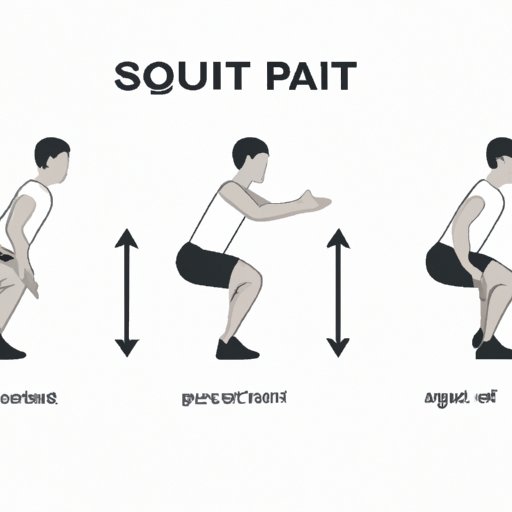
Introduction
Squatting is a versatile exercise that targets multiple muscle groups, making it an essential component of any effective workout routine. Squats are not only beneficial for building strength and endurance but also for improving mobility, balance, and bone density. In this article, we will break down the proper squatting technique, discuss common mistakes and how to avoid them, explore various squatting variations to mix up your routine, and provide tips and tricks for better results.
The Benefits of Squatting: Why It Should Be a Part of Your Workout Routine
Before diving into the proper squatting technique, it’s crucial to understand the benefits of including squats in your workout routine. Squats are a compound exercise that engages multiple muscle groups simultaneously. Engaging in squatting exercises helps you to build overall strength, including your core, glutes, and legs. Some of the significant physical benefits of squatting include boosting overall strength, improving posture, increasing bone density, and burning calories. Squats are also vital for mental health and overall well-being, as they release endorphins, boost self-confidence, and improve sleep quality. Research indicates that squats are beneficial in the prevention of diseases such as osteoporosis, type 2 diabetes, and heart disease.
The Proper Squatting Technique: A Step-By-Step Guide
The foundation of proper squatting technique is correct form. A basic squat requires your feet to be shoulder-width apart, your toes pointed outward, and your knees and toes aligned. Begin the movement by pushing your hips back as if sitting on a chair while in a standing position. Make sure that your knees stay consistent with your toes. Keep your chest lifted, and your core engaged throughout the movement. Lower down until your hips and knees form a 90-degree angle. Then, press up through your heels and engage your glutes, driving your hips forward until you return to a standing position.
Remember, proper form is critical when it comes to squatting. Take your time to master the technique before adding intensity or weights. If necessary, break down each step into even more steps, starting with plain air squats and then proceeding to add weights when you feel confident.
Squatting Do’s and Don’ts: Mistakes to Avoid During Your Squat
In proper squatting technique, it’s essential to avoid common mistakes to avoid injury and improve overall fitness gains. Some of the mistakes to avoid include improper foot placement, lack of hip hinge, incorrect knee alignment, rounding of the spine, and lifting the heels from the ground. Always ensure that your feet are in line and your knees are aligned with your toes throughout the movement. Avoid rounding the spine by keeping the core strong and shoulders aligned, and your chest lifted.
Additionally, ensure that your feet remain flat and pressed into the floor throughout the movement. Understand that the movement should begin with a hip hinge movement, not a downward movement that puts undue stress on the knees. Also, avoid lifting the heels to maintain balance and prevent potential injury.
How to Improve Your Squatting Form: Tips and Tricks for Better Results
Proper squatting technique is vital for effective squats, but certain tips and tricks can help you achieve better results. Some of the ways you can improve your squatting form include practicing mobility exercises, adjusting foot position, or using a weightlifting belt. Using mobility exercises helps you to improve your flexibility, reduce stiffness, and increase your range of motion while squatting. Adjusting your foot position from shoulder-width to slightly wider than shoulder-width can help to target different muscles while squatting. Lastly, using a weightlifting belt can help maintain proper alignment as you lift heavier weights.
Squat Variations: Mixing Up Your Routine for Maximum Fitness Gains
To avoid monotony and maintain motivation, squat variations are a fantastic way to spice up your workout routine. Some variations to consider include goblet squats, front squats, and barbell squats. Goblet squats are a perfect option for beginners, while front squats allow for more quad engagement, and barbell squats target a wide range of muscles. Incorporating different squat variations into your workout routine can help you target specific areas, which is essential for progressive overload and better results.
The Importance of Warming Up: How to Prepare for a Successful Squatting Session
Before commencing any squatting session, you should warm up your body to prevent potential injury and improve overall performance. Some of the warm-up exercises you can incorporate include foam rolling, dynamic stretching, and reverse lunges. A foam roller helps to release tension in your muscles, and dynamic stretching helps to warm your muscles for safe exercise. Reverse lunges help activate your glutes, improve balance, and enhance proprioception.
Troubleshooting Squatting Problems: Common Issues and How to Fix Them
Despite adhering to proper form and technique, squatting issues can still arise. Common problems include the lack of mobility, knee pain, or difficulties balancing. Always ensure you address the underlying issue before proceeding. To improve mobility, practice other exercises that target specific areas, take breaks, and perform warm-up exercises. Knee pain, typically from a misalignment, can be mitigated by ensuring you maintain proper form. Difficulty balancing can stem from less core strength, in which you should reinforce your core strengthening and stabilization exercises during your workouts.
Conclusion
Squats are an essential exercise for overall fitness and strength-building. Proper squatting technique is critical in preventing injuries and achieving optimal fitness gains. Remember always to prioritize proper form, avoid common mistakes, and include variations in your routine for maximum results. Stay injury-free and achieve optimal long-term fitness by integrating safe and proper squat form into your next workout.




